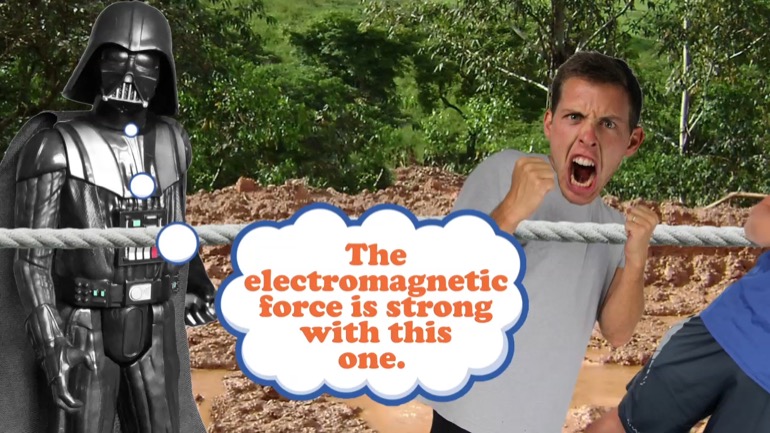ShmoopTube
Where Monty Python meets your 10th grade teacher.
Search Thousands of Shmoop Videos
Physics Videos 34 videos
Isaac Newton. Who was he? Why do we need to know about him? In a physics course, no less? Well, he's only the most famous physicist in history, and...
What are the basics of trigonometry? And why are we learning about this in a physics course? Both good questions. In this video, you'll learn about...
It's time to make our liters and meters work together. Enough of the bickering, right? In this video, we'll do some unit analysis, covering SI Unit...
Physics: Graphs Tell Stories, and Stories Tell Us Equations 11 Views
Share It!
Description:
Graphs tell stories, and stories tell us equations. We hope graphs choose a good story to tell us...maybe Harry Potter, or something.
Transcript
- 00:01
No grafs tell stories and stories tell us equations Okay
- 00:06
using graphs to tell a story that's Pleasant feeling that's
- 00:13
What stories Dad in the matter A lot of math
- 00:21
Okay Equations instead Action movie equation Yeah Okay who didn't
- 00:31
love story time when they were a kid Who indeed
Full Transcript
- 00:35
you'd gather around have your mom or dad or your
- 00:38
teacher read from a picture book and they'd hold up
- 00:41
the pages so you could see the illustrations everyone would
- 00:44
Who and ah and physics is just like that Okay
- 00:50
there may be a few small differences but think of
- 00:53
grafts They tell us stories through pictures We just need
- 00:56
to know how to read them If you've been following
- 00:59
along with our course so far you've already seen a
- 01:02
bunch of displacement versus time Graphs like this one Displacement
- 01:06
versus time gives us information about velocity versus time And
- 01:10
in the same way velocity versus time tells us about
- 01:13
the acceleration versus time But rather than just yammer on
- 01:17
about it let's see what story this graph is telling
- 01:20
us What do we see here We see something that
- 01:24
starts moving picks up speed then slows down What story
- 01:28
could we think of that fits this Sure there are
- 01:31
a lot of situations to choose from That would match
- 01:33
this like a car going from one stop Sign to
- 01:35
another Although the car would probably be going faster than
- 01:38
this What if uncle frank decides to relive his roller
- 01:42
disco glory years The seventies were a crazy groovy time
- 01:47
Now frank isn't the king of the roller rink like
- 01:49
he used to be So when he comes to a
- 01:51
hill he's just gonna roll with it literally he's not
- 01:55
going to add any force He's just going to pray
- 01:58
he doesn't fracture his pelvis We'll be observing him helping
- 02:01
the video of disco uncle goes viral so we'll say
- 02:05
frank is rolling in the positive direction away from us
- 02:08
He rolls down the hill for about two point five
- 02:11
meters when he starts going up the next hill which
- 02:14
means he slows down of course and he stops after
- 02:18
ten seconds five meters away from the us Sure that
- 02:22
story where it's great for those graph Maybe not so
- 02:24
great for frank though And what does this graph tell
- 02:27
us about velocity over time Well since the overall slope
- 02:31
of the line is upwards the velocity will be positive
- 02:34
And since this is a curved line the velocity isn't
- 02:37
constant It changes throughout the time period So if we
- 02:41
were to plot out a velocity versus time graph It
- 02:43
would look like this Frankie starts out at zero meters
- 02:48
per second preaches a max of one meter per second
- 02:51
and then gravity kicks in and slows him down until
- 02:54
it's back teo zero meters per second Before we go
- 02:57
onto acceleration let's look at the slope of the velocity
- 03:00
graph more carefully And let's Think about what it means
- 03:03
for acceleration We can see that the slope is constant
- 03:07
and positive from zero to five seconds then abruptly changes
- 03:12
to constant and negative in the five to ten second
- 03:15
region That abrupt change of five seconds tells us that
- 03:19
is the moment when the acceleration was not uniform In
- 03:22
other words acceleration changes at five seconds as we're sure
- 03:26
you mutter in your sleep these days acceleration is the
- 03:30
change in velocity divided by the change in time Yep
- 03:34
That equation looks pretty familiar So for the first part
- 03:37
of the velocity graph the outboard part we would figure
- 03:41
out the acceleration like this Well look at the change
- 03:44
in velocity from second zero two second four Why aren't
- 03:48
we going all the way to the top two second
- 03:50
five Because we already know that the acceleration at that
- 03:54
time is zero that's the transition point So in that
- 03:58
four second time span the velocity goes from zero meters
- 04:01
per second Two zero point eight meters per second We
- 04:05
divide that change in velocity by that change in time
- 04:09
to find that our acceleration for the first four seconds
- 04:12
And when we do the math we find that the
- 04:15
acceleration is a constant point Two meters per second squared
- 04:19
let's Slap that sucker on the acceleration versus time graph
- 04:23
Let's look at the other part That part has the
- 04:26
downward slope A second six through ten Another four seconds
- 04:31
Man at second ten our velocity is zero meters per
- 04:35
second at second Six it's point eight meters per second
- 04:40
giving us a change of negative point Eight meters per
- 04:42
second Divide that by the change in time which gives
- 04:46
us an acceleration of negative point Two meters per second
- 04:50
squared Well pop that on the graft too So right
- 04:53
now our graph looks a little dysfunctional huh A little
- 04:56
disconnected like us before our first cup of coffee So
- 05:00
let's fix that by adding the point at the five
- 05:03
second mark where The acceleration is zero Then we can
- 05:07
connect our two horizontal lines much better Looking at that
- 05:11
disconnected graff was making us itch It's a super important
- 05:15
to keep the time when the acceleration is changing out
- 05:18
of both the before and after pictures Think of what
- 05:21
would happen if we looked at zero through five then
- 05:24
five through ten then at the five second point we'd
- 05:27
have a vertical line Ah vertical line on a time
- 05:30
graph is bad Very very bad acceleration is change in
- 05:35
velocity over change in time if there's no change in
- 05:39
time that means we'd be dividing by zero And as
- 05:42
we were all taught in math class when you divide
- 05:44
by zero you open a portal to hell that swallows
- 05:48
the universe in a fury apocalypse Ok it's not quite
- 05:52
that bad but she can't divide something by nothing It's
- 05:55
nonsensical and in math terms is considered undefined And if
- 06:00
you have a vertical line on an acceleration vs the
- 06:02
time graph that would mean that the acceleration was infinite
- 06:07
Which just know nope Uh uh not gonna happen So
- 06:13
graph carefully when acceleration is changing So displacement velocity and
- 06:17
acceleration are all related part of one big happy family
- 06:22
let's take a look at some ways to work with
- 06:24
them Time for some equations We've already looked at some
- 06:29
basic equations Displacement equals final position minus the original position
- 06:34
Velocity equals the change in displacement over a period of
- 06:38
time Acceleration is the change in velocity over a change
- 06:42
in time But how about this bad boy What the
- 06:46
heck is is trying to say let's Break it down
- 06:49
x final is our final displacement wherever we've ended up
- 06:54
in other words x sub zero is our initial displacement
- 06:58
also known as where we started out these sub zero
- 07:01
is our initial velocity and t stands for time so
- 07:05
this is initial velocity multiplied by the elapsed time a
- 07:10
is acceleration pretty standard Auntie is still time But in
- 07:14
this part we square it so putting it all together
- 07:17
our final displacement equals our initial displacement plus our initial
- 07:22
velocity times the time period plus one half acceleration times
- 07:28
time squared Now you may look at this See all
- 07:33
those variables and want to crawl under your desk and
- 07:35
die We get it But all those variables are a
- 07:38
good thing because it means that if we have enough
- 07:41
info we can solve for the initial velocity initial or
- 07:45
final displacement time or acceleration Look at that versatility That's
- 07:50
like the swiss army knife of equations How about this
- 07:54
one This says that the final displacement minus the initial
- 07:58
displacement equals the final velocity minus the starting velocity divided
- 08:03
by two multiplied by the elapsed time So to put
- 08:08
it another way the change in displacement equals the average
- 08:11
velocity multiplied by the elapsed time so we can know
- 08:15
how far we went If we have our average velocity
- 08:18
and a clock that could definitely come in handy But
- 08:22
what if we don't have the time Well we always
- 08:25
have the time for math But what if no one
- 08:27
was watching the clock So we don't know how much
- 08:30
time passed Good news there's An equation we can use
- 08:33
in that situation Here it is Let's Break this one
- 08:37
down The final velocity squared equals the initial velocity also
- 08:42
squared two times acceleration times the difference between the final
- 08:48
displacement and the initial displacement which is also known as
- 08:52
the change in displacement This cuts the time right out
- 08:55
and lets us solve for the initial or final displacement
- 08:59
initial or final velocity and acceleration How do we know
- 09:03
which equation to use We take attendance that's How Just
- 09:07
like in class for these kinds of questions we've only
- 09:10
got six variables that we're going to run into We've
- 09:14
got the displacement brothers that's initial and final displacement and
- 09:18
the velocity twins initial and final there too Then we've
- 09:22
got acceleration and last but not least time no relation
- 09:26
between those two look through the question see which variables
- 09:30
were given and which we need to solve for So
- 09:33
if both displacements both velocities and acceleration are all present
- 09:37
and time isn't mentioned we'll pick the right equation for
- 09:40
the job and sometimes we might need more than one
- 09:43
equation like if there are different kinds of motion that
- 09:47
the car is at a stop sign accelerates then cruises
- 09:50
on the freeway for a while If we want to
- 09:52
know the total displacement we'll need an equation that describes
- 09:55
this displacement during the acceleration un equation that tells us
- 09:59
the final velocity and the one that tells us how
- 10:02
far the car went at that velocity or what if
- 10:05
we have a case of two moving objects like the
- 10:08
old classic of two trains if we have a train
- 10:11
going from chicago to detroit and another going from detroit
- 10:14
to chicago will need different equations for each to figure
- 10:18
out when they're going to crash Come on just having
- 10:21
them past each other is so boring So how does
- 10:24
this whole taking attendance thing work Exactly Let's see it
- 10:27
in action say we've got a superhero situation since we're
- 10:31
always staying on brand let's call her shmoop er woman
- 10:35
she's just chillin up on a roof when she hears
- 10:37
a distress call she takes off running thirty meters to
- 10:40
the end of the roof She hits the edge of
- 10:42
the roof and takes flight When she gets to the
- 10:45
end she has a velocity of five meters per second
- 10:49
How long does this sprint taker to cover those thirty
- 10:52
meters time for attendance Unnatural displacement here there mary is
- 10:58
And just because he's zero doesn't mean he's worthless What
- 11:01
about the final displacement Yep Thirty meters right Their initial
- 11:05
velocity Bingo Zero meters per second Final velocity That's definitely
- 11:11
showed up five meters per second acceleration Uh acceleration Anyone
- 11:17
sane acceleration Uh yes acceleration is out sick How about
- 11:22
time Oh yeah That's what we're trying to figure out
- 11:25
so which equation should be used Let's look at some
- 11:28
of our options since acceleration isn't involved we don't want
- 11:32
any equation with an a so we can scratch the
- 11:36
acceleration equation off the list and we can also scratch
- 11:39
captain versatile off also the big one with all the
- 11:42
variables we could use it but we'd have to calculate
- 11:45
acceleration first So let's look at something simpler This one
- 11:49
requires us to find the average velocity first again Sounds
- 11:53
like extra work and we know we don't want this
- 11:55
velocity equation It's whole thing is that it doesn't involve
- 12:00
time That leaves us with this equation Remember this one
- 12:04
final displacement minus initial displacement equals final velocity minus initial
- 12:10
velocity divided by two times the time that's got everything
- 12:16
we need Okay first of all let's isolate t that
- 12:20
is what we're trying to solve After all let's get
- 12:23
algebraic on It will start by multiplying both sides by
- 12:27
two so now we've got two times the difference in
- 12:29
displacement equals the difference in velocity times time one more
- 12:34
step to get t all by itself divide both sides
- 12:37
by the change in velocity Leaving us with this time
- 12:43
equals two times the difference in displacement over the difference
- 12:47
in velocity Let's start putting in the Numbers the final
- 12:50
displacement was 30 meters and the initial displacement was zero
- 12:54
meters so those go there and the final velocity was
- 12:58
five meters per second with an initial velocity of zero
- 13:02
meters per second So we'll pop that in right there
- 13:06
we won't actually do the whole subtracting zero from numbers
- 13:09
thing we think he can handle that just fine so
- 13:12
we have sixty meters on top and five meters per
- 13:15
second on the bottom sixty divided by five is twelve
- 13:18
and when we look at the units the meter's cancel
- 13:21
out leaving us with a time of twelve seconds and
- 13:25
shmoop er woman saves the day again A lot of
- 13:28
math is like telling a story we've got your beginning
- 13:31
when you get all the numbers and what to solve
- 13:33
for then you've got your middle where you make any
- 13:35
rearrangements and do the math and at the end you
- 13:38
got your answer but will grant you that meth is
- 13:41
in the most Popular story to tell You'll probably see
- 13:43
a superhero movie in the next few months But equations
- 13:48
Those aren't quite ready for the big screen yet Bring 00:13:50.818 --> [endTime] it back
Related Videos
When you're about to marry the love of your life, not many things could stop you. However, finding out that your future hubby is keeping his crazy...
Here at Shmoop, we work for kids, not just the bottom line. Founded by David Siminoff and his wife Ellen Siminoff, Shmoop was originally conceived...
ACT Math: Elementary Algebra Drill 4, Problem 5. What is the solution to the problem shown?
AP® English Literature and Composition Passage Drill 1, Problem 1. Which literary device is used in lines 31 to 37?
AP® English Literature and Composition Passage Drill 2, Problem 1. What claim does Bacon make that contradicts the maxim "Whatsoever is delig...






































